Contributory members are able to log private notes and comments about each site
Sites Anne T has logged. View this log as a table or view the most recent logs from everyone
St Cuthbert's Church (Corsenside)
Trip No.149 Entry No.3 Date Added: 9th Sep 2019
Site Type: Ancient Cross
Country: England (Northumberland)
Visited: Yes on 8th Sep 2019. My rating: Condition 3 Ambience 4 Access 4
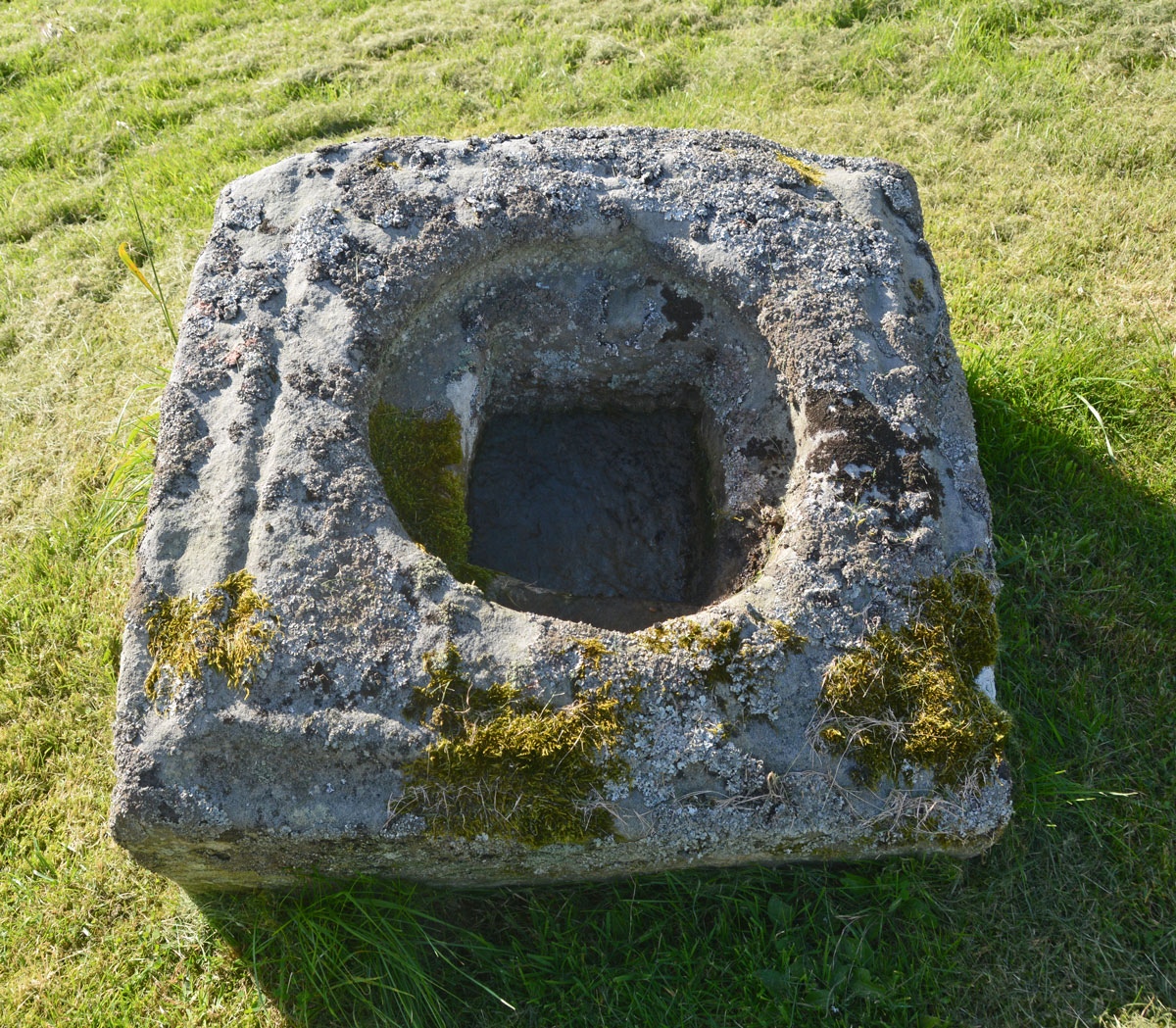
St Cuthbert's Church (Corsenside) submitted by Anne T on 9th Sep 2019. A look down into this 0.8m square socket stone, which has a shallow rectangular socket hole at the bottom of a circular depression. The top of the stone has a single roll moulding around its edge.
(View photo, vote or add a comment)
Log Text: Cross base at St Cuthbert's, Corsenside: This church is a little gem. After having let ourselves in through 2 gates (one by the A68, the other near the church), the views around the church are lovely. The church was open, and we were surprised to find out how old the chancel and sanctuary are. There were some very interesting grave markers inside the church, including one which was possibly a Tudor wayside cross.
The socket stone is exactly where described, and is one of the most ornate we’ve seen. Although a simple rectangle in shape, the rectangular socket stone as a circular depression above it, and in turn a small gully running just inside the top surface.
St Mary the Virgin (Blanchland)
Trip No.149 Entry No.4 Date Added: 12th Sep 2019
Site Type: Ancient Cross
Country: England (Northumberland)
Visited: Yes on 8th Sep 2019. My rating: Condition 3 Ambience 4 Access 4
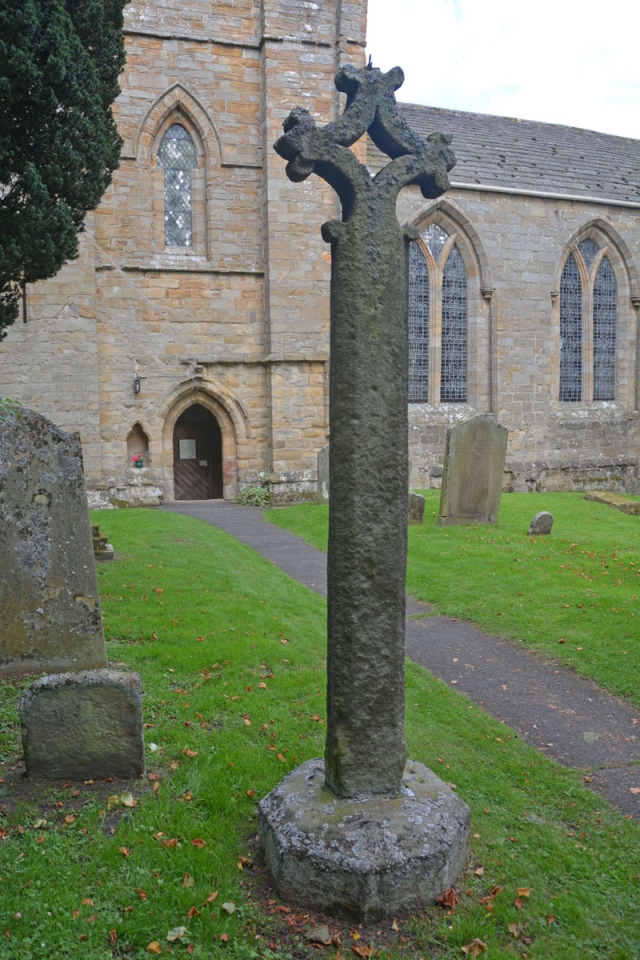
St Mary the Virgin (Blanchland) submitted by Anne T on 10th Sep 2019. Showing where this 13th century cross sits in the churchyard in relation to the west door of the church. We had previously thought this was a relatively modern grave marker, but Pastscape and Historic England both confirm it is a "rare survival of a complete medieval churchyard cross".
(View photo, vote or add a comment)
Log Text: Churchyard Cross, Blanchland: The grid reference given by Pastscape is incorrect; theirs places it on moorland to the north west of the village. The cross is at NY 96598 50408.
Blanchland is a relatively remote, but really lovely medieval village, near the border with County Durham. The site of one of five Premonstratensian Abbeys in north-eastern England, with this church having once formed the centre of worship at the monastery here. Today, only part of the church survives, in a really unusual L-shaped form. After the Reformation, the church was left to become ruined, but was partially restored in the mid-18th century. The current building is formed from the north transept (with the tower at its northern end) and the eastern arm of the medieval Abbey church.
We have been to this church before (and occasionally to the Lord Crewe Arms next door, but more often to the White Monk Tearooms opposite). We thought that this churchyard cross was actually a modern grave marker, as it looks relatively modern, but is what Pastscape and Historic England class as "a rare survival" of a complete medieval churchyard cross.
Inside, the church feels somewhat bare, but there are six interesting grave slabs set into the floor of the north transept. Peter Ryder has recorded these, saying they are "without close local parallels".
To see the eastern external walls of the church, you need to relax in the beer garden of the Lord Crewe Arms!
Corbridge Crosses
Trip No.149 Entry No.2 Date Added: 12th Sep 2019
Site Type: Ancient Cross
Country: England (Northumberland)
Visited: Yes on 8th Sep 2019. My rating: Condition 3 Ambience 4 Access 5

Corbridge Crosses submitted by Anne T on 12th Sep 2019. The old market cross, which stood upon steps and a Roman altar, was removed from it's original place in 1807, and stood outside the Roman Catholic Cathedral in Newcastle. It was returned to Corbridge in the 20th century, but now sits 2m to the east of the door into the Pele Tower. Very worn, it once had an inscription, plus dog tooth ornament.
(View photo, vote or add a comment)
Log Text: Corbridge Market Crosses: This is our local village, with some excellent shops, but apart from the church, I've never actually stopped to photograph any of the crosses or the Vicar's Pele. We decided to remedy that today, although with it being a Sunday, I tried to get a photograph of the new market cross without visitors sitting around it, eating lunch. Still, it's lovely to know it's still part of this very active community.
The old cross is very sadly tucked 2m away from the door into the Vicar's Pele - now a micro-pub, with dog's water bowls, tables and chairs and a planter immediately adjacent.
On my wish list is gathering the courage to go into the very small Vicar's Pele and photograph the medieval grave slabs built into its structure, without managing to annoy anyone drinking in there - it is a popular place!
Old Prior Manor House Well (Corbridge)
Trip No.149 Entry No.1 Date Added: 12th Sep 2019
Site Type: Holy Well or Sacred Spring
Country: England (Northumberland)
Visited: Yes on 8th Sep 2019. My rating: Condition 3 Ambience 3 Access 5

Old Prior Manor House Well (Corbridge) submitted by Anne T on 12th Sep 2019. A glimpse into the well chamber. It has two pottery pipes feeding into it, and a modern drain in front which takes away any overflow. The water, after a long period of very warm and wet weather, was full of bright green weed.The well lies at the eastern side of what would have been the grounds of the old Trinity Church, which was demolished in the 18th century after falling into ruins.
(View photo, vote or add a comment)
Log Text: We have driven past this well so many times and said “we need to stop and photograph this” and today we did. I thought it was just a hollow in the wall, with a dry pipe coming through the wall, but no, it is a real well, with water, although no water flowed through the pipe and the water was stagnant and full of vibrant green weed.
Looking over the wall, it had a stone domed well house.
The well is located outside the Old Prior Manor House, at the corner of the B6529, Stagshaw Road and St Helen’s Lane, with the junction with Corchester Lane, which runs to the Corbridge Roman site, diagonally opposite to the south west.
The OS map of 1895 shows the well being sited opposite Trinity Church. The house, also known as Prior Mains, was formerly the Corbridge Rectory.
Bywell Cross
Trip No.150 Entry No.1 Date Added: 12th Sep 2019
Site Type: Ancient Cross
Country: England (Northumberland)
Visited: Yes on 10th Sep 2019. My rating: Condition 3 Ambience 4 Access 5
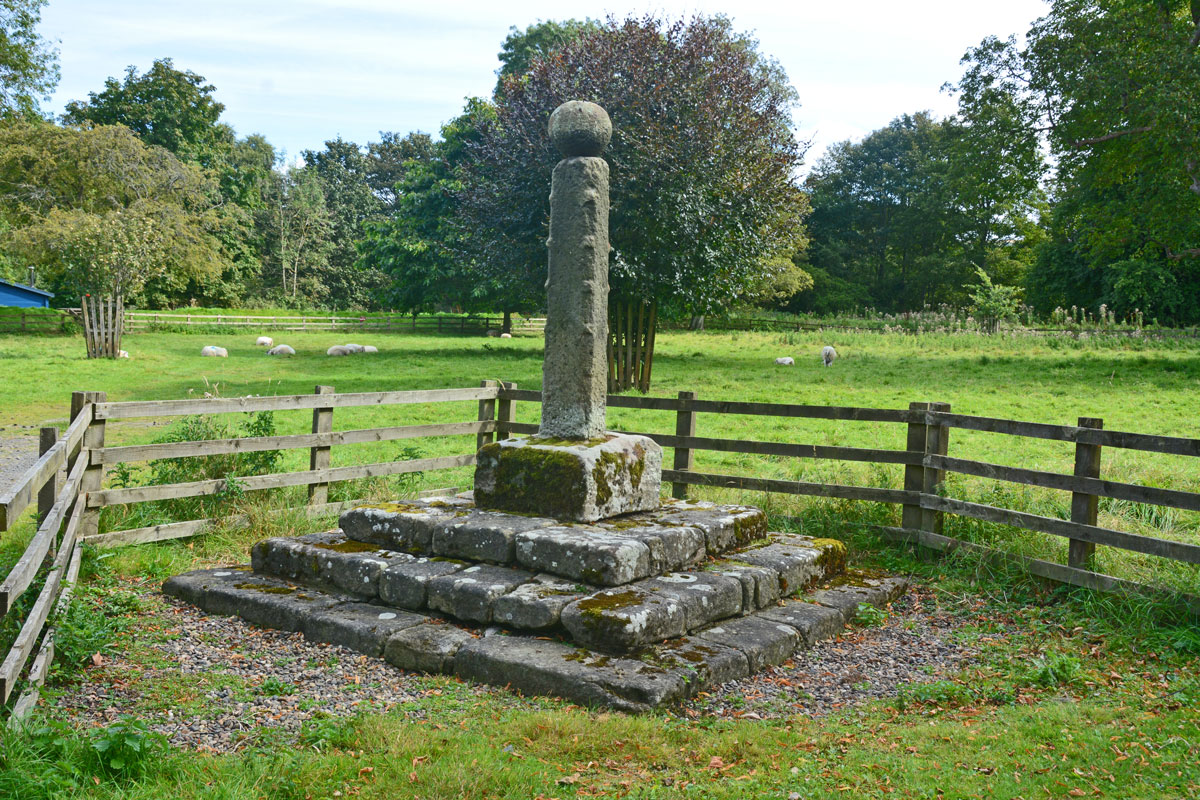
Bywell Cross submitted by Anne T on 12th Sep 2019. First view of the thirteenth century cross, moved from NZ 04876145 to its current location in 1852. It is grade II listed and stands 2.8m tall. The ball finial is dated to 1700.
(View photo, vote or add a comment)
Log Text: Bywell Cross: Considering we live less than a couple of miles from here, and we regularly pop down to walk around here, I've never really stopped to photograph the cross here. Having decided to photograph the medieval cross slabs in St Andrew's church, I got the camera out, only to find another visitor stopped to look at it.
The gentleman told me he'd been doing an annual walk around this area for the last 5(?) years, and was heading off to Ovingham/Ovington next. I decided to come back and photograph the cross after going to St Andrew's, only to find him still there!
This is a very lovely, peaceful spot, with the River Tyne about 50m away. He did eventually wander off after a brief conversation, and I popped into the field to get a photograph of the cross from its eastern side.
Old Viney Museum (Corbridge)
Trip No.151 Entry No.2 Date Added: 16th Sep 2019
Site Type: Sculptured Stone
Country: England (Northumberland)
Visited: Yes on 14th Sep 2019. My rating: Condition 3 Ambience 4 Access 4
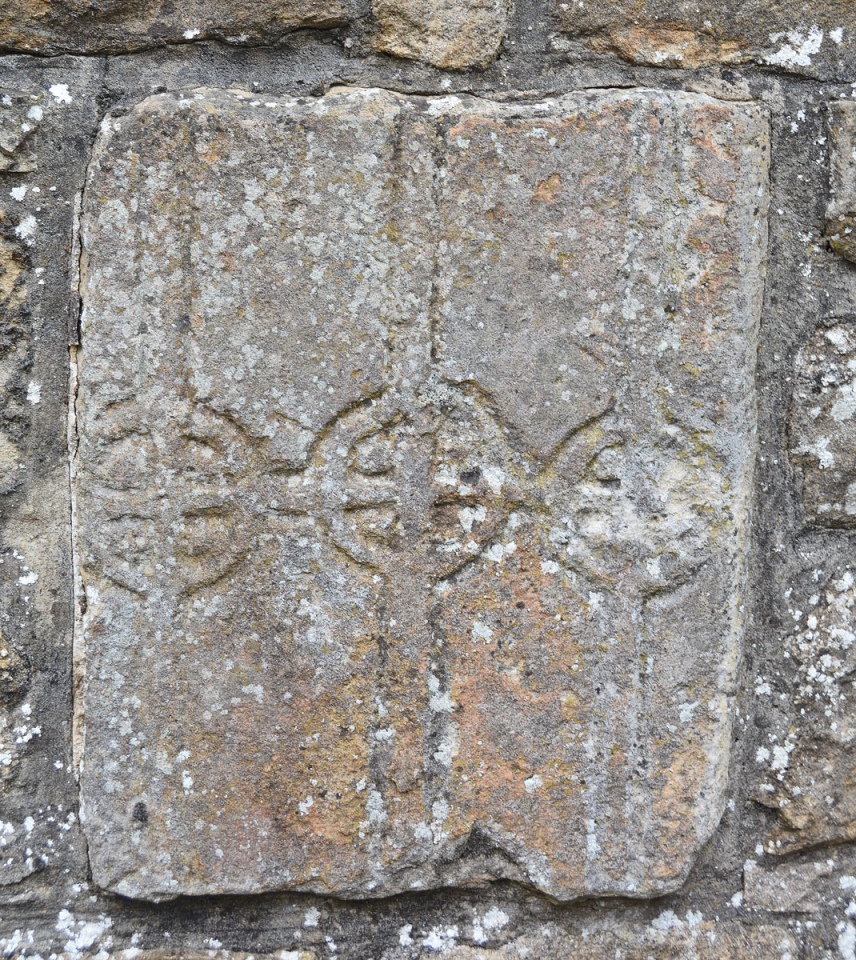
Old Viney Museum (Corbridge) submitted by Anne T on 16th Sep 2019. This stone is built into a wall at the northern side of the cottage, inside the garden. It is recorded as Ryder's Viney 3 and as the Corpus of Anglo Saxon Stone Sculpture's Corbridge 02. It is part carved with three stemmed crosses joined by horizontal arms, and is thought to have been created during the Saxon-Norman overlap period. "The centre of each cross is ringed and within the ring the arms are narrower than the uprights." The Corpus suggests it might have been the side of an altar or...
(View photo, vote or add a comment)
Log Text: The Old Viney Museum, Corbridge: [Photographed the Prince's Street Pant at the corner of the road prior to walking up Appletree Lane.] We had long sought out the location of this museum, where we knew some of the stones recorded on the Corpus of Anglo Saxon Stone Sculpture were built into its walls. Having found Peter Ryder's Cross Slab papers for south west Northumberland, we finally had a street, so went seeking the property, thinking we'd be able to see it from outside.
We were really fortunate to find the owner of the cottage working in his garage, and he was delighted to show us round, leaving us to take photographs. He was also really interested in the documentation I'd taken along (I have since sent him a copy by way of thanks). His father purchased the museum and adjacent school buildings in the 1970s and his family has owned them ever since.
What a treat! I felt so lucky to be welcomed in and to see these stones, which we've wanted to see for at least three years now. Brilliant.
St Andrew's Church (Corbridge)
Date Added: 26th Sep 2019
Site Type: Ancient Cross
Country: England (Northumberland)
Visited: Yes on 14th Sep 2019. My rating: Condition 3 Ambience 4 Access 5
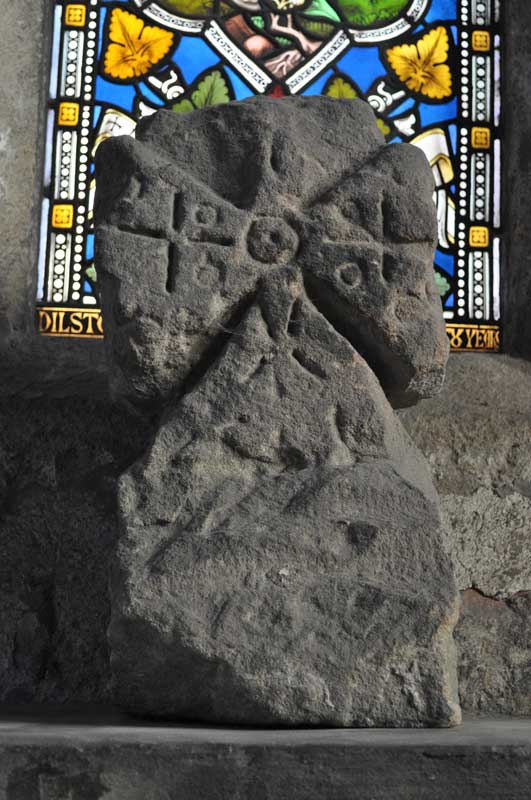
St Andrew's Church (Corbridge) submitted by Anne T on 7th Oct 2014. The eleventh century finial, though to be from the gable end of the original church. Currently located in the South Transept
(ASCorpus ref: Corbridge 05).
(View photo, vote or add a comment)
Log Text: St. Andrew's Church, Corbridge: We returned to this beautiful church, right in the heart of Corbridge, with Peter Ryder's list of medieval grave slabs. Not to be confused with St. Andrew's, Bywell, about 6 miles away.
Always a draw for visitors, this is a peaceful and thought provoking church. As we started on our list of slabs, working out way down the list from 1-21, the Canon came in with a couple of choristers and started practicing for a service, so parts of the church were 'out of bounds' to avoid disturbing them. We returned briefly on Sunday, 22nd September, mid-afternoon, to photograph the couple of slabs remaining. We were unable to find slab 21, but later realised we were looking in the wrong place, so will return to complete the list.
Todley Hill Mound (Great Whittingham)
Trip No.92 Entry No.2 Date Added: 21st Aug 2018
Site Type: Misc. Earthwork
Country: England (Northamptonshire)
Visited: Yes on 21st Aug 2018. My rating: Condition 3 Ambience 4 Access 4
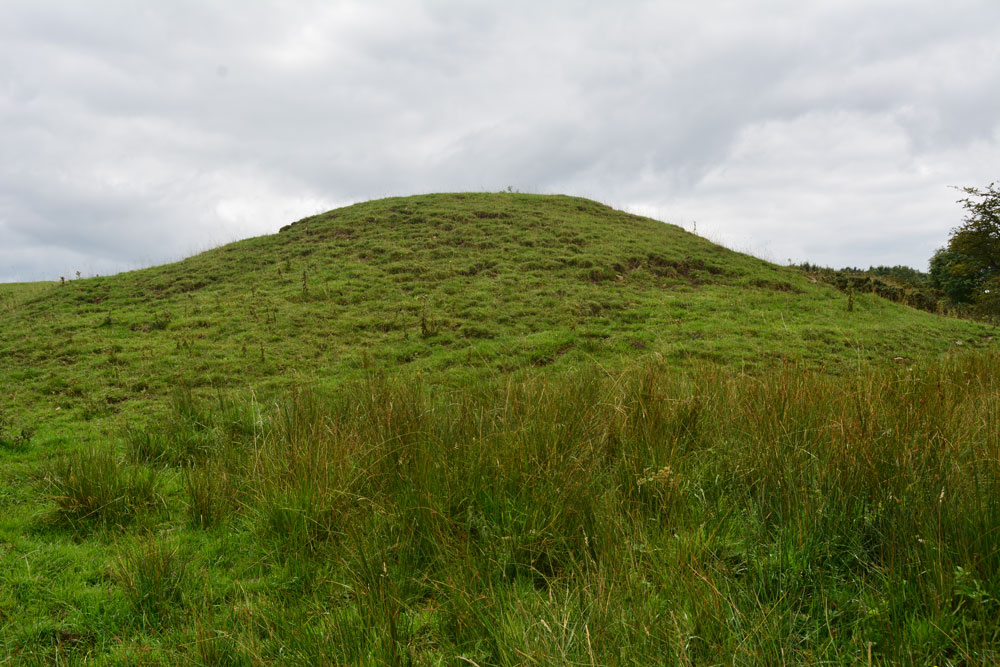
Todley Hill Mound (Great Whittingham) submitted by Anne T on 21st Aug 2018. Standing by the small ford across the stream to the north of the mound, looking south as the mound rises high above us.
(View photo, vote or add a comment)
Log Text: Todley Hill Mound, near Great Whittingham: Walking back to the car, we saw a couple of vans with trailers belonging to the farmers, and I was looking for someone to ask permission to enter the field to see the mound, but whilst the trailer doors were left wide open, no people were visible. There was a gate into the field at NY 99675 71602, almost opposite where we’d parked the car, but there was a stream in the way. We opted to drive further back up the road, and parked at NY 99488 71218, where the road widens out into a large field entrance and dump for roadstone.
The gate into the field had been chained shut, so we walked back down the road and found part of the fence we could hop over.
This is a large mound, in a pretty spot with a small stream to its northern side. There appeared to be a large earth-fast boulder towards its south western side, with smaller boulders surrounding it, but the latter had been broken and were probably field clearance.
Walking round the mound, it appeared to us to have vague traces of a kerb with boulders/stones poking through, mainly on its southern and eastern sides.
This mound/tumulus/barrow is right on the old Roman Road, the Devil’s Causeway, jus to the east of where this cuts the modern road. The vague remains of an edge of this road can be seen (possibly) in the field opposite, to the south of the small stream (or it maybe modern uplift from dredging the stream).
This really had the feel of a barrow to me, and I enjoyed walking round it.
Asfordby Cross
Trip No.121 Entry No.2 Date Added: 19th Mar 2019
Site Type: Ancient Cross
Country: England (Leicestershire and Rutland)
Visited: Yes on 17th Mar 2019. My rating: Condition 3 Ambience 3 Access 5
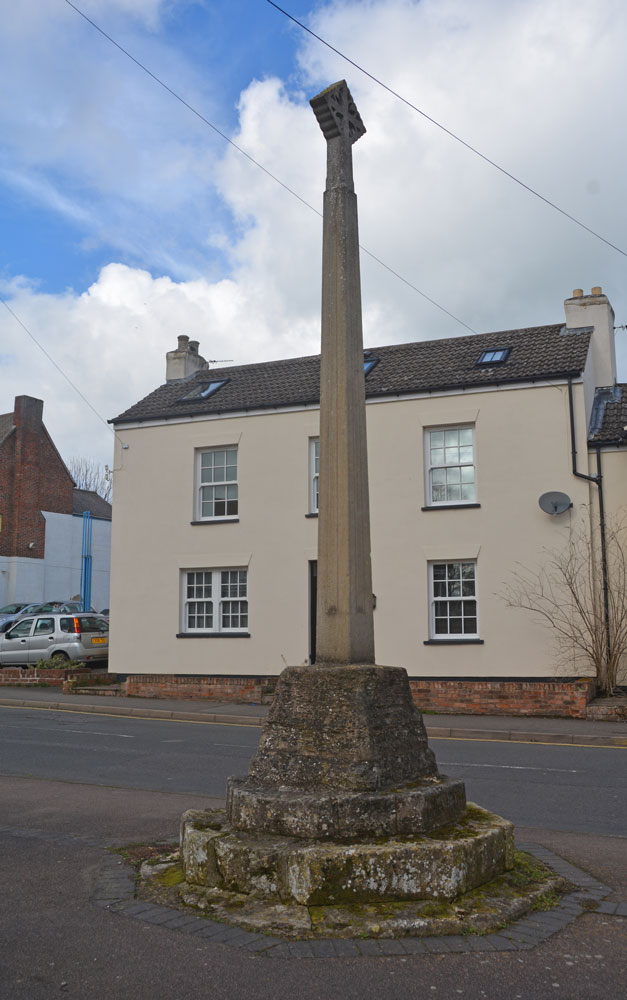
Asfordby Cross submitted by Anne T on 19th Mar 2019. Village Cross in Leicestershire and Rutland England. Standing at the south side of Main Street, where it joins Church Lane, looking north across the cross. The cross shaft and cross are very obviously modern, although the socket stone and steps look much older (although Pastscape says these are not original).
(View photo, vote or add a comment)
Log Text: Asfordby Village Cross: Not really much to see, as the cross shaft is obviously modern, on an older base, but as this was just round the corner from All Saints, we whizzed round to take a very quick look.
Bottesford Cross
Trip No.121 Entry No.6 Date Added: 19th Mar 2019
Site Type: Ancient Cross
Country: England (Leicestershire and Rutland)
Visited: Yes on 17th Mar 2019. My rating: Condition 3 Ambience 3 Access 5
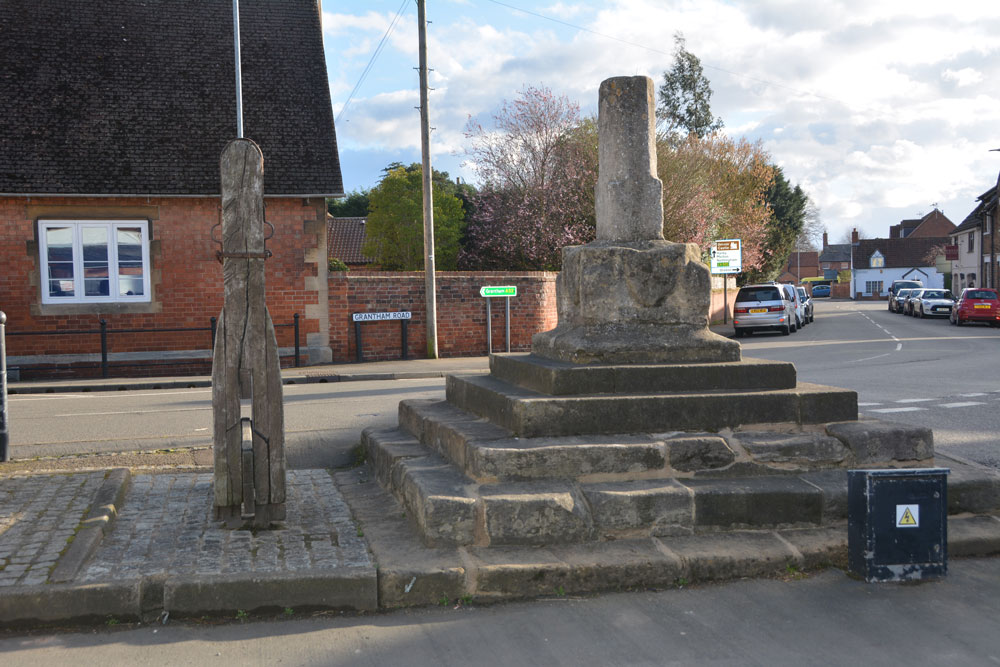
Bottesford Cross submitted by Anne T on 19th Mar 2019. Market Cross in Leicestershire and Rutland England. Looking east across the market cross and the remains of the stocks and whipping post, down Grantham Road.
(View photo, vote or add a comment)
Log Text: Market Cross, Bottesford: We saw this purely by chance as we turned down the road heading north towards the A1 and home, and stopped to take photographs. The village stocks and whipping post were right next to the cross, which was placed on top of five steps, the top two of which are modern repairs.
King's Norton
Trip No.78 Entry No.3 Date Added: 25th Jun 2018
Site Type: Holy Well or Sacred Spring
Country: England (Leicestershire and Rutland)
Visited: Yes on 24th Jun 2018. My rating: Condition 3 Ambience 3 Access 5

King's Norton submitted by enkidu41 on 31st Aug 2004.
(View photo, vote or add a comment)
Log Text: Well, St John The Baptist, King's Norton: This is a very posh village, with very large houses. We parked by the tiny little village green just to the west of the church, almost next to the well, which is low down in the western churchyard wall.
Someone has been refurbishing the well, and recently, as there is a fresh footprint or two in the sand now forming the bottom of the well pool.
The church is relatively modern, a plaque next to the gate describing it as ‘Georgian Gothic’. The churchyard is relatively small, and not much to see in it, apart from a huge memorial right up against the exterior eastern wall. The church itself was locked, although a name/phone number was given to collect the keys from, but we weren’t interested enough to go inside.
Pastscape describes this well as a ‘horsetrough’. Whilst the well was very dry at the time of our visit, there is no sign within the churchyard (or the neighbouring house) as to where the source of the water comes from, although the top of the ground is at least 2m higher behind the well.
St Michael's Church (Illston On The Hill)
Trip No.78 Entry No.2 Date Added: 25th Jun 2018
Site Type: Ancient Cross
Country: England (Leicestershire and Rutland)
Visited: Yes on 24th Jun 2018. My rating: Condition 3 Ambience 4 Access 5

St Michael's Church (Illston On The Hill) submitted by Anne T on 25th Jun 2018. Close up of the socket stone and remains of cross shaft, looking towards the south porch from the southern edge of the churchyard, next to Main Street.
(View photo, vote or add a comment)
Log Text: St. Michael's Church, Illston on the Hill: This was our first port of call on the Sunday afternoon, on a brilliantly sunny day with blue skies and very hot. Although we probably could have walked here with the dog from Billesdon, I certainly wasn’t feeling up to a long walk today, and was very grateful that the cross was only just off the road.
A very pretty little church, which seemed larger on the inside than the out. The inside of the church wasn’t particularly interesting, apart from a very unusual set of steps that ran up to the top of the rood, from just behind the pulpit.
The cross was unusual, with the socket stone being set straight into the ground (no base or steps) and the remains of the cross shaft set diagonally into the socket. The shaft also had rolled-moulded edges. Also unusual was that it was set almost directly against three large gravestones which loomed above it.
St John The Baptist (Rolleston)
Trip No.78 Entry No.4 Date Added: 26th Jun 2018
Site Type: Ancient Cross
Country: England (Leicestershire and Rutland)
Visited: Yes on 24th Jun 2018. My rating: Condition 3 Ambience 3 Access 4

St John The Baptist (Rolleston) submitted by Anne T on 26th Jun 2018. Site in Leicestershire and Rutland England. The floriated cross head looks more modern than the worn capital underneath.
(View photo, vote or add a comment)
Log Text: Churchyard Cross, St John The Baptist, Rolleston: Apart from one sign post on the road by the church in Skeffington, this exclusive hamlet may well not exist. The road is gated (at least 3 gates), the roads are very narrow, and at the junction of the road and the bridlepath down to the church, there are a number of ‘no parking’ signs. This meant our daughter-in-law-to-be had to drop us off and drive some distance away, then collect us afterwards.
There is a small iron gate into the churchyard. This appears to be the only entrance, as the road at the eastern end of the church is labelled ‘private’. Eventually managing to open the gate into the church, we found the cross at the south eastern corner of the church, almost hidden in the shadows of the trees. It looked as if the owner of the modern house had incorporated this part of the churchyard into their private garden, so we very much felt like we were trespassing and expected someone to come out of the house and shout at us to ‘move on’.
Due to the heavy shadows and bright sunlight, it was a little difficult to photograph this cross. There appears to be a difference of opinion between Historic England and Pastscape as to the date of this cross – HE says 14th century; Pastscape 17th. The socket stone was marginally intriguing as it had a small hole in each side, presumably to drain any water away.
Making our way back along the gated road to civilisation, we stopped by the stream to let the dog paddle.
St Bartholomew (Sproxton)
Trip No.121 Entry No.3 Date Added: 19th Mar 2019
Site Type: Ancient Cross
Country: England (Leicestershire and Rutland)
Visited: Yes on 17th Mar 2019. My rating: Condition 3 Ambience 4 Access 4

St Bartholomew (Sproxton) submitted by Anne T on 19th Mar 2019. Anglo Scandinavian Cross in Leicestershire and Rutland England. This is some of the detailed work on the northern, narrow, face of the cross.
(View photo, vote or add a comment)
Log Text: Sproxton Cross, St Bartholomew's Church: This church was a little way out of the village and we parked in a small metalled area next to a 'gallop' at SK 85667 24972 and braved the wind to walk back down the road to the gate into the churchyard.
The vicar had previously told us the cross had been moved inside the church, but looking after 11 churches in total, he must have been confused, because as soon as we rounded the west end of the church to reach the entrance through the south porch, the cross came into sight. What is inside the church is an 11th century cross slab/grave marker.
This is a very quiet spot, apart from the occasional car that came hurtling past.
The inside of the church appears relatively modern, but has some really interesting corbels. We also found a portion of carving, either part of a fluted column, or cemented to it, next to the north western side of the door into the tower.
We did have a good scout around for the shaped stone in the south western wall mentioned by The Journal of Antiquities, but were unable to find it.
In the field to the south of the church is a well, but could find no mention of this on Pastscape or Historic England.
All Saints (Asfordby)
Trip No.121 Entry No.1 Date Added: 24th Mar 2019
Site Type: Ancient Cross
Country: England (Leicestershire and Rutland)
Visited: Yes on 17th Mar 2019. My rating: Condition 3 Ambience 4 Access 4
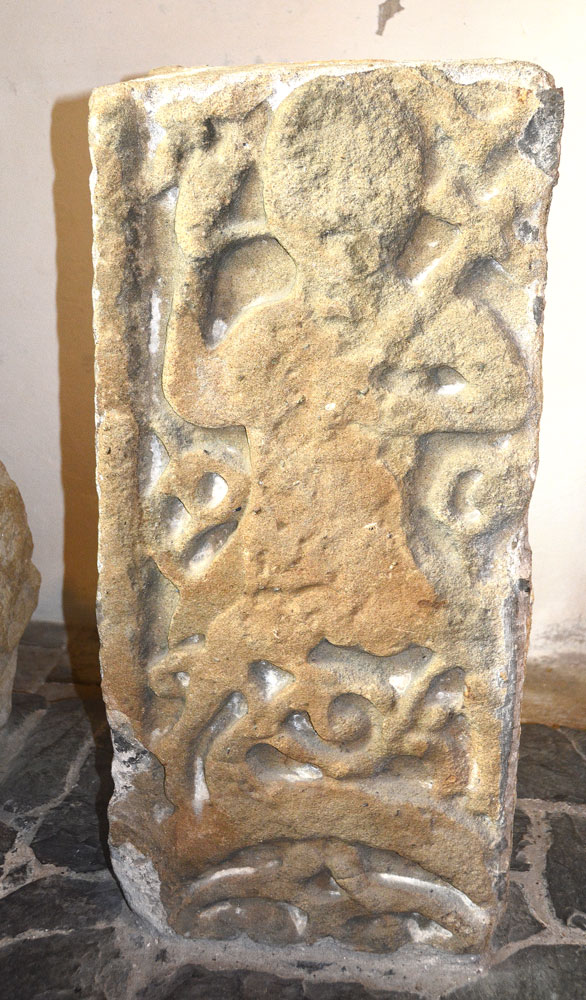
All Saints (Asfordby) submitted by Anne T on 19th Mar 2019. Anglo Saxon cross shaft fragments in Leicestershire and Rutland England. This is the figure 'giving a blessing' on the front of the central of the three fragments. Whilst in the church we debated whether the figure was holding a cross or an axe in its left hand. I favoured an axe, but given where it was, the preferred thinking is that it is a cross!
(View photo, vote or add a comment)
Log Text: All Saints, Asfordby: The church is usually open on Saturdays between 2pm and 4pm, but we were fortunate because there was a service here today, from 10.30am until 11.30am, so we arrived as close as we could to the finish time of the service (which, because we got lost, was 12 noon). The congregation was having coffee and biscuits, but made us hugely welcome – even our son and DIL’s Labrador was allowed into the church and made a fuss of. The vicar had very kindly made arrangements for us to meet the Secretary and Historian of the church, who warmly welcomed us, introduced us to the Curate, and showed us round the church.
All Saints is very obviously a vibrant, active church, and the building is well used for community activities, which is lovely to see.
Miriam, the historian, very kindly showed us the three Anglo Saxon stones cemented into the far south western corner of the nave, with members of the congregation very kindly re-arranging tables and chairs for us to have easier access.
I came prepared with a list of features I really wanted to see, including the rare Tudor painted bench end (next to a pillar just to the east at the north western corner of the nave), the Green Man (on a boss high up in the middle of the nave) and Norman aumbry (in the northern wall at the north eastern corner of the nave) with its original Norman chevrons. Miriam also pointed out a ‘ladder’ (stairway to heaven) on the pillar at the north eastern side of the nave, and pilgrim crosses and what looked like a scratch sundial on the external western side of the door frame into the church.
I really could have spent a lot longer in the church, as it had a lovely, calm, reflective atmosphere and would love to attend a service here.
St Michael and All Angels (Harston)
Trip No.121 Entry No.4 Date Added: 19th Mar 2019
Site Type: Ancient Cross
Country: England (Leicestershire and Rutland)
Visited: Yes on 17th Mar 2019. My rating: Condition 3 Ambience 3 Access 4
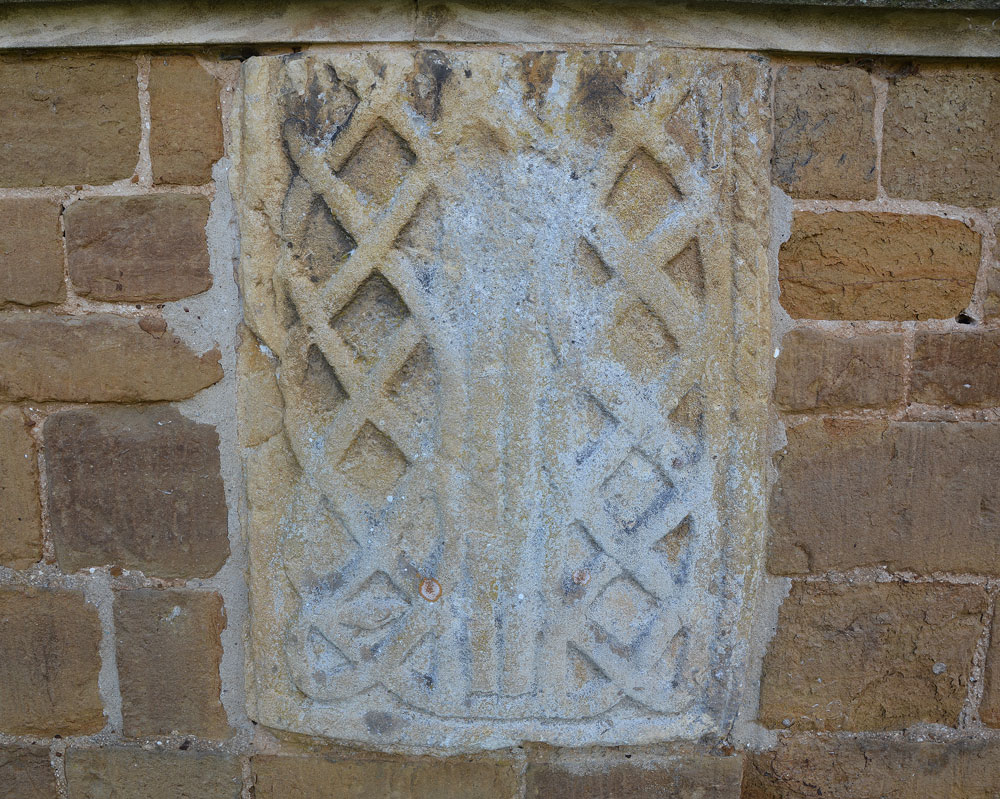
St Michael and All Angels (Harston) submitted by Anne T on 19th Mar 2019. Ancient cross in Leicestershire and Rutland England. This is the fragment of Anglo Saxon stone embedded in the exterior east wall of the church, immediately underneath the east window. Prof. Rosemary Cramp in her paper "New Directions in the study of Anglo Saxon Sculpture" (page 4) describes this as part of a grave cover.
(View photo, vote or add a comment)
Log Text: Anglo Saxon cross fragments, St Michael and All Angels, Harston: Before visiting, I wasn’t able to find out much about the church or the AS stone fragments. I was hoping for a church guide book, but there was nothing. There were newspaper articles and photos of the bell tower and the bells displayed in the bell tower, but nothing was made of the fragments – one in the external east wall, and another in the south porch. Pastscape mentions that the stone in the east wall is possibly part of a cross shaft
The church looks very appealing from the outside, being made of warm, yellow stone. Inside it is very Victorian. The only thing of any age appeared to be the stem of the font.
Nice to have been able to drop by and photograph the fragments.
St Peter's Church (Redmile)
Trip No.121 Entry No.5 Date Added: 19th Mar 2019
Site Type: Early Christian Sculptured Stone
Country: England (Leicestershire and Rutland)
Visited: Yes on 17th Mar 2019. My rating: Condition 3 Ambience 3 Access 4
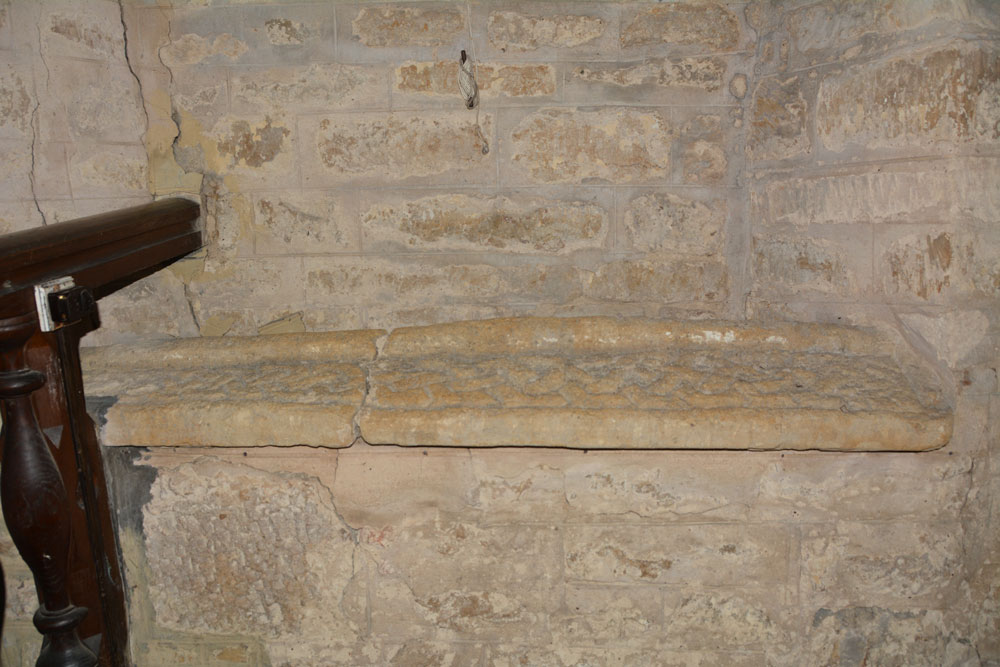
St Peter's Church (Redmile) submitted by Anne T on 19th Mar 2019. Anglo Saxon Carved Stone in Leicestershire and Rutland England. The carved stone, now reused as a windowsill.
(View photo, vote or add a comment)
Log Text: Carved Anglo Saxon Stone, St Peter's Church, Redmile: Our last planned visit before heading off home, and this church didn't disappoint, despite being greeted by "Warning. Falling Masonry" signs on entering the church through the south door! The north western part of the nave was cordoned off, with similar notices.
No two walls of this church were plumb, and the cracking in the north wall was quite spectacular. However, the atmosphere of the church was warm and friendly, and we felt relatively safe knowing there had been a service there only that morning.
We found the stone, reused as a windowsill, easily enough. Placed under a window by the pulpit, it proved a little tricky to photograph, and I could have done with a ladder to photograph all of it from above.
I also spotted what could have been what looked like another fragment in the south wall of the church, and Andrew found 'witches marks' on the eastern external jamb of the south porch.
Rothley Cross
Date Added: 20th Mar 2019
Site Type: Ancient Cross
Country: England (Leicestershire and Rutland)
Visited: Yes on 17th Mar 2019. My rating: Condition 3 Ambience 4 Access 4
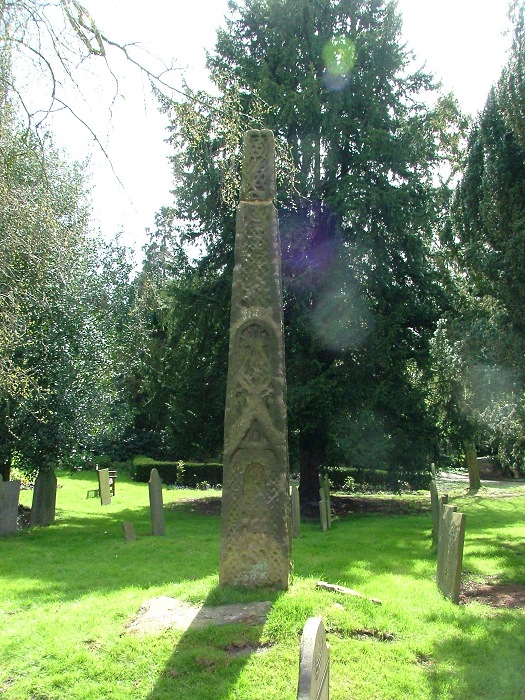
Rothley Cross submitted by gautrek on 20th Apr 2005. An Anglo-Saxon cross dating from the mid ninth century. It is 9ft high.it can be found in the grounds of St Mary and St John the Baptist church in Rothley.OS map (Charnwood,O.S.129, SK586126)
(View photo, vote or add a comment)
Log Text: The Rothley Cross, Leicestershire: The church is usually kept locked, but we had arranged to pick up a key from the Parish Office mid-afternoon. However, calling at the office, there was no reply. Walking back to the church, I spoke to a lady who had been busy clearing the churchyard of broken branches, and she told us the administrator had gone home ill. However, fortuitously, she had a key to the vestry and very kindly let us in.
The church has a long history, and has some amazing grave slabs and a Norman font. The bases of the pillars are said to date to the original Norman church. We found a cross scratched into one of the pillars.
The Rothley Cross is to be found to the south east of the church, near some tall yew trees. At the time of our visit, the cross was in deep shade, although the worn carving was still visible.
We also spotted an unsual carved mark - much more ornate than a mason's mark on the external western jamb of the vestry door.
St Mary and St Hardulf (Breedon on the Hill)
Trip No.120 Entry No.1 Date Added: 20th Mar 2019
Site Type: Ancient Cross
Country: England (Leicestershire and Rutland)
Visited: Yes on 15th Mar 2019. My rating: Condition 3 Ambience 5 Access 4
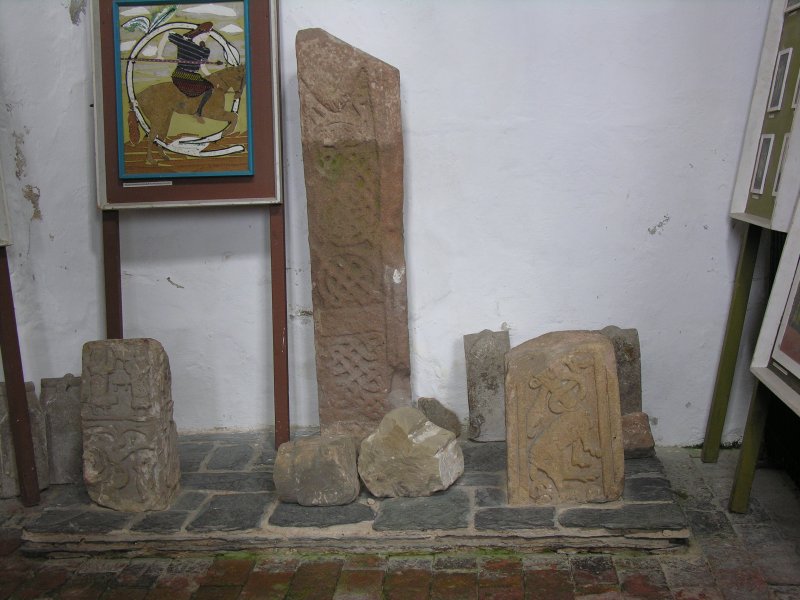
St Mary and St Hardulf (Breedon on the Hill) submitted by TimPrevett on 23rd Sep 2007. Just some of the Saxon stones in Breedon on the Hill church. Visit for yourself to take in the many stones incorporated into the fabric!
(View photo, vote or add a comment)
Log Text: St Mary & St Hardulph, Breedon on the Hill: This church is visible from miles around, perched on top of its hill, which used to be an Iron Age hillfort (The Bulwarks). Most of the fortifications have been quarried away, and at the eastern side of the church there is a steep drop down into a large quarry, protected by a substantial metal fence and barbed wire. This is also the site of a beacon.
We arrived on a day when there was a weather warning for high winds, and my goodness, the winds were high. Other walkers were sitting in their cars in the small car park at the viewpoint, whilst we struggled to open the car doors and braved the winds to walk up to the south porch to let ourselves into the church! I am glad I had my husband with me, as the wind made the outer porch door rattle badly and it sounded as if a group of people were standing just outside the door having a muffled conversation. Very spooky, although the atmosphere in the church was friendly and welcoming, and I could have spent several more hours here.
There is a church guide with a plan of the stones, but not all of them are included individually. I went armed with a copy of A W Clapham's paper "The Carved Stones at Breedon on the Hill, Leicestershire, and their position in the History of English Art". I had problems linking his descriptions with the actual stones, so ended up making my own drawing and labelling the stones and photo numbers, so it was easier to 'unpick' once I was at home.
I could have spent at least several more hours here, but time was pressing, and I left reluctantly, to brave the wind yet again!
St John the Evangelist (Gressingham)
Date Added: 6th Jun 2015
Site Type: Ancient Cross
Country: England (Lancashire)
Visited: Yes on 4th Jun 2015. My rating: Condition 3 Ambience 4 Access 5
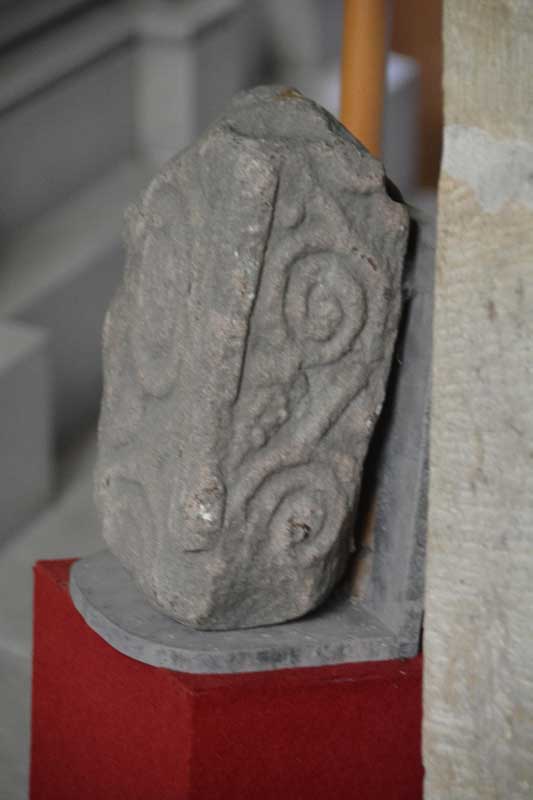
St John the Evangelist (Gressingham) submitted by Anne T on 6th Jun 2015. A photograph showing the side of the cross fragment inside the church. As it was securely fastened to the wall, I was unable to turn it round to photograph the reverse side.
(View photo, vote or add a comment)
Log Text: 9th Century Anglo Saxon Cross Fragments, St John The Evangelist, Gressingham: Having decided upon a day out in Lancashire/Cumbria on an Anglo Saxon Cross hunt, this was our stop of the day. We approached from junction 35 of the M6, taking the B6254 through Over Kellet and taking a right hand turn, named Fall Kirk, down to Gressingham. This is a pretty little village with the church on the junction of Fall Kirk and Back Lane, sited on a hill next to a small stream which joins the River Lune to the south. Not having phoned through before visiting, we were delighted to find the church open, with a lovely Norman arch over the entrance door on the south wall. But whilst it was warm and sunny outside, this Grade 1 listed church was cold inside.
Whilst the Pastscape and Wikipedia notes talk about more than one fragment of 9th cross inside the church, we could only spot one, despite a thorough hunt by both of us. This was strapped into the north-east corner of the nave, just before a large tomb for George Marton, so I was unable to turn it round to photograph the reverse side. The 9th cross shaft built into the external south-west corner of the nave was easy to spot, with the sunlight picking out the decoration nicely [note: having reviewed the Pastscape notes, another fragment might be inside the vestry, which we didn't check].
There was a pulpit of dark wood dated 1714 on the south side of the church, and retained some of the original box pews. There was also a tapestry on hessian against the south wall, opposite the chest tomb and the stone fragment which caught my imagination – someone has put a lot of hard work into this.
